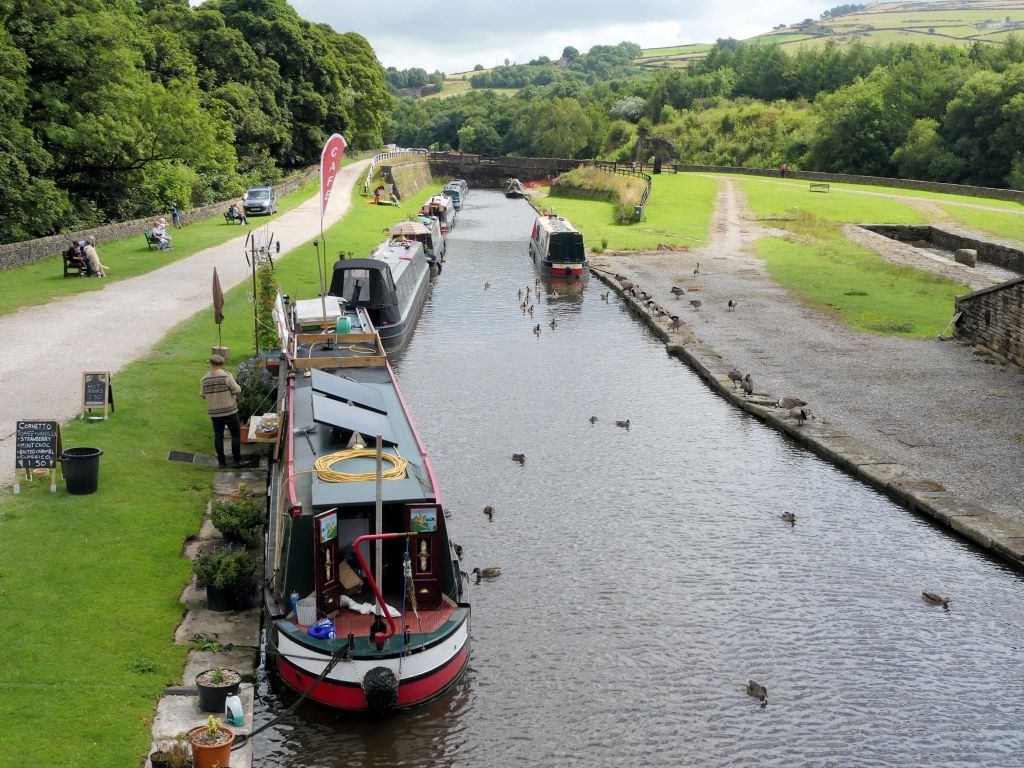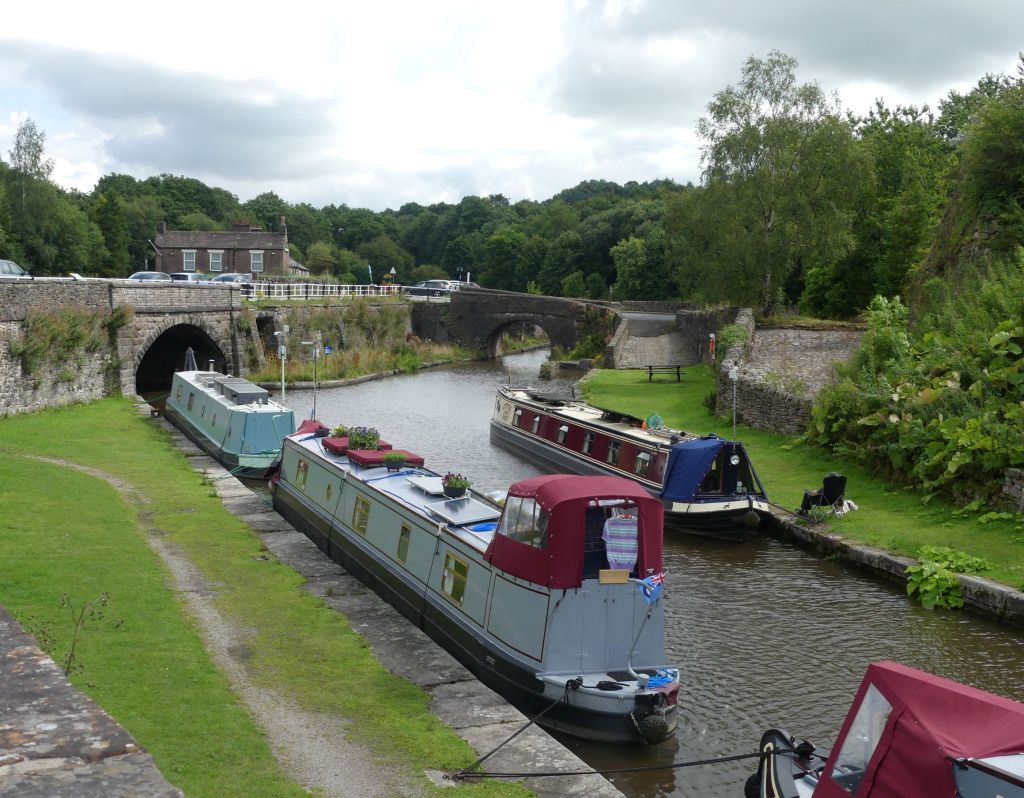One of the few positives to emerge from the pandemic is that it has encouraged us to spend more time exploring our local area, rather than hot-footing it across the rest of the UK and the wider world. Who knew, for example, that the Bugsworth Basin, in our own home county of Derbyshire, was once was the largest and busiest inland port on Britain’s canal system? Not me, and I’ve lived here over 40 years. Nor Mrs P either, and she’s lived in Derbyshire her entire life.

The Bugsworth Basin was the terminus of the 14 mile long Peak Forest Canal. Built between 1794 and 1804, the canal linked Bugsworth Basin with Manchester and the trans-Pennine canal network.
The basin was also the end-point of the Peak Forest Tramway. Completed in 1795, the tramway was used to move stone from some of Derbyshire’s biggest quarries to the canal basin. Together, the tramway and canal made it possible for stone extracted in Derbyshire to be transported throughout the North-West and the Midlands.

Although some gritstone was moved by canal, most of the freight loaded at Bugsworth Basin was limestone. When converted into calcium oxide (otherwise known as burnt lime or quicklime), limestone plays a pivotal role in the manufacture of steel. Demand for steel grew rapidly after the Industrial Revolution took hold in the late 18th century, driving in turn a huge growth in demand for limestone. As a result, the Peak Forest Canal and Bugsworth Basin flourished.
At its height in the 1880s, around 600 tons (544 tonne) of limestone per day was being shipped from Bugsworth Basin. Some calcium oxide was also prepared on-site at the basin, before being shipped out to customers via the canal network. It must have seemed that the good days would last forever. But they didn’t, of course, courtesy of the changing industrial landscape and competition from railways. All traffic ceased in 1921, and by 1923 the basin had closed and was falling into disrepair.

But, as Bob Dylan was so fond of telling us, the times they are a-changing. The basin and canal may have no role to play in modern freight transport, but there are opportunities aplenty in the recreation and leisure industries. Restoration began in the 1960s and took more than 40 years. Bugsworth Basin and the Peak Forest Canal have been reborn.
Although there are a few structures dating from the heyday of the industrial period, including the remains of a lime kiln where limestone was roasted to make calcium oxide, Bugsworth Basin wears its history lightly. Today, as Mrs P and I witnessed when we visited in August, the basin is thronged with colourful barges piloted by recreational waterways enthusiasts.

Meanwhile the towpath echoes to the footsteps of dog walkers and casual visitors keen to soak up the relaxed atmosphere. Cyclists whizz merrily along, grateful for somewhere flat to pursue their hobby in our notoriously hilly county, while birdwatchers keep an eye open for kingfishers.
Bugsworth Basin is now a scheduled Ancient Monument, and before Covid struck was attracting 50,000 visitors a year. It’s a real asset for Derbyshire’s tourist industry, and for ordinary folk like us who just want to escape into a different world for a few hours. What a pity that it took a global pandemic for Mrs P and I to finally discover this hidden gem on our doorstep.
Interesting to read about the changes to the industry. Nothing lasts forever, does it?
LikeLiked by 1 person
Yes, one of my favourite quotes, courtesy of George Harrison (via Lao-Tzu and Timothy Leary) is “All Things Must Pass”, which I find comforting when life gets difficult. Future generations will doubtless regard the internal combustion engine as a quaint aberration, which is pretty much how we now look upon the great age of canals. All things will indeed pass.
LikeLike
Hi there. Like you, during the pandemic I’ve discovered local areas that I didn’t know about. For example, my township, which is near Philadelphia, has an enormous park that contains ball fields, playgrounds, tennis courts, picnic areas, walking trails, etc. The park is about a mile and a half from my house. Yet, I’d never been there till a few months ago.
LikeLiked by 1 person
Crazy isn’t it, all the places in our own backyard that are unknown to us. When the Covid lockdown was at its height we discovered a whole network of footpaths on our housing estate, within a stone’s throw of our front door, that we knew nothing of…and we’ve lived here 35 years. I’m not at all proud of that!
LikeLiked by 1 person
I really hope to be able to take part in one of the canal trips some day. Thanks for the renewed inspiration.
LikeLiked by 1 person
I hope you get to do it one day. When she was growing up Mrs P and her family used to take a summer holiday on the canals every year. She says it was a peaceful and uplifting experience. and a great way to see the countryside from an unfamiliar perspective.
LikeLike
The restoration and repurposing of old and decaying structures is often very rewarding on many different levels. As is getting one’s own neck of the woods. I’m glad Bugsworth Basin is experiencing a new, idyllic life.
LikeLiked by 1 person
Yes, idyllic is the word. I wonder what the 19th century canal workers, and the poor old horses that pulled the barges back then, would make of its reincarnation?
LikeLiked by 1 person
The horses might be relieved about not having to haul barges any longer. And maybe the workers would enjoy taking a ride on one of the modern-day barges.
LikeLiked by 1 person
Interesting read. Of course our canals couldn’t hope to compete once the railways became established, and their contribution to history (and geology, for that matter – thinking of William Smith) doesn’t always get that much attention. It is good that they have found a new purpose with recreation.
LikeLiked by 1 person
Yes, today canals like this feel like a haven of peace and tranquillity…and don’t we need some of that right now! Thank you for reminding me about the geological angle of the Canal Age, including the insights of William Smith. It takes an enormous effort of imagination these days to properly understand the impact that construction and operation of the canal network must have had on C18/C19 Britain…for sure, it was revolutionary.
LikeLiked by 1 person
A fascinating slice of history!
LikeLiked by 1 person
Thank you. I like canals, relics of a time when life was much simpler and a bit less hectic!
LikeLike
Me too! And I like these utilitarian things from history rather than the relics of feudal times.
LikeLiked by 1 person
I think they are in the process of restoring part of the historic canal in Washington DC, complete with vessels for tourists to ride. Looks like fun!
LikeLiked by 1 person
Sounds like a fascinating project. Definitely worth a trip when it’s operating!
LikeLiked by 1 person